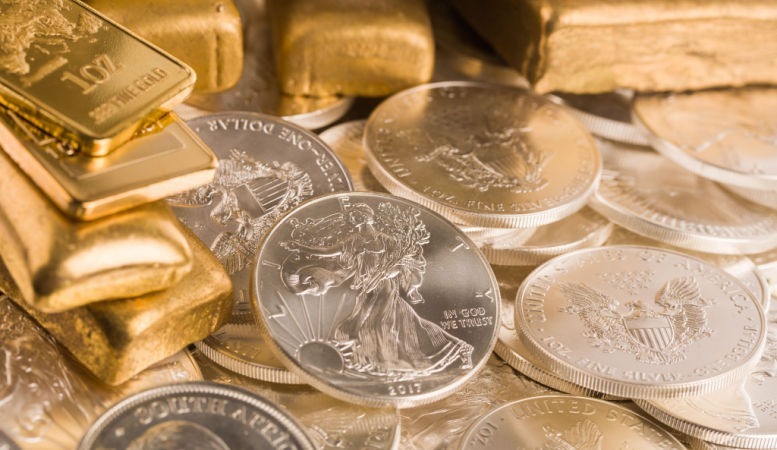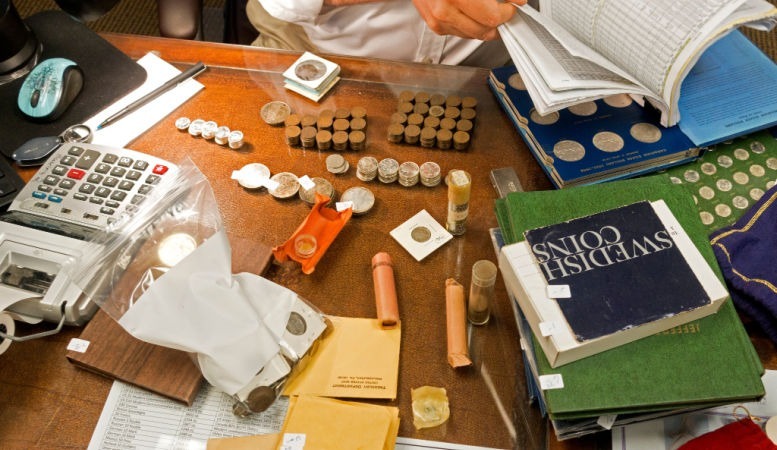Table of Contents
Whether you’re planning for retirement or want to maximize your portfolio’s performance, diversification is key to maximizing your investments.
Precious metals such as gold and silver remain desirable for their corrosion resistance, rarity, and decorative value. But is investing in precious metals the right choice for you in a post-COVID world? This guide explains the most important aspects of buying gold and silver for those new to the process.
Investing Terms You Should Know
Physical investments come with some key terms. These include:
- Allocated gold: Allocated metals are physical gold or silver bullion stored in a third-party vault. The allocated metal does not form part of the vault provider’s balance sheet because it belongs to the owner.
- Bull: In investment terms, “bull” means the expectation that prices will rise. A bullish trader believes that a commodity will increase in value, and a bull market refers to a rising price over time.
- Bear: In investment terms, “bear” refers to the expectation of falling prices. A bear market is one in which prices consistently fall.
- Exchange-traded funds (ETFs): The main purpose of ETFs is to track the market price of assets such as gold or silver by buying into them. Investors can buy shares in the trust but do not get access to the fund’s underlying assets. Gold ETFs are like stocks in a company, but instead of buying shares in a company, you buy shares in a fund that relies on asset prices for its profits and losses.
- Fineness: Investment gold and silver use fineness to describe their purity level. Fineness refers to how many parts of a bar or coin are pure gold or silver per thousand parts.
- Paper gold: A paper asset, such as paper gold, refers to any investment that derives value from gold prices but does not involve ownership of the physical asset. Examples include gold ETFs, gold futures, stocks in mining companies, and mutual funds.
- Troy ounce: A specific weight measurement for precious metals. It’s slightly heavier than the traditional imperial ounce and is the default trading unit for the spot price of gold and silver.
Reasons To Consider Investing in Gold and Silver

Investing in a completely new asset class can feel intimidating, and many people need good reasons to allocate valuable resources to these investments. Here are some of the main reasons why investing in precious metals may be a good option:
- Precious metals are in high demand: Platinum and palladium are automotive industry staples, and the electronics industry has a growing need for gold. Since mining precious metals has become more difficult and expensive, the increasing demand results in a subsequent price increase.
- Relatively high liquidity: Unlike other physical assets, many eager buyers are ready to buy precious metals. This high liquidity means you can react quickly to changing market conditions.
- Confidentiality: While you may need to deal with a third-party vault to safely store your gold and silver, you do not need to provide your details to a financial institution to sell or purchase gold.
Warning Signs of Investment Scams
As more people become interested in gold and silver investing, many dubious dealers are tricking potential investors with investment scams.
Investment fraud can be difficult to distinguish from genuine investment opportunities. However, investment scams often come with warning signs, including:
- Guaranteed high returns with no risk
- Seminars and travel offers
- Hard sell tactics (time pressure, abrupt language, cold calls, etc.)
- Highly complex terminology with no explanation or clarification
If you’re in doubt that an investing consultant is legitimate, be sure to check their credentials. Investment professionals must register with several investment bodies, including FINRA, the SEC, and state securities and insurance regulatory bodies. You can contact these agencies directly or use a third-party site such as BrokerCheck to review a consultant’s credentials and registration.
Different Kinds of Gold and Silver Investments

If you’ve decided to invest in precious metals, either as a hedge against inflation or in a gold IRA for your retirement, your next step will be to determine what type of gold to buy. While bullion is the most common, you may also invest in gold-related paper assets that derive their value from gold’s performance, if not both.
Physical Gold
Physical precious metals come in various shapes and sizes. The most common are:
- Bullion
- Numismatic coins
- Jewelry
Each physical asset has advantages and disadvantages and is suitable for different investment types.
Formal investment vehicles such as IRAs have stringent requirements regarding the gold you buy and how you store it. The IRS requires that any silver purchase for an IRA must be of a certain fineness and come from a registered mint. Also, you’ll need to find a registered storage facility to store your investment—you aren’t allowed to store your gold bars at home or in an unregistered vault.
Numismatic coins, which have a value outside their gold or silver content, make great family heirlooms and offer the added advantages of high liquidity and collectability that other forms of bullion lack.
Jewelry may be easier to get and store than formal gold bullion investment vehicles but presents several challenges, making it unsuitable as a long-term investment.
Mining Stocks
Buying mining stocks is an interesting option for investing in gold. Since mining companies benefit from high precious metal prices, any market ups will reflect on the mining stocks. However, you need to be familiar with the stock market and be ready to read some stock investing tips or work with a professional stock market broker to maximize your investment.
Mutual Funds/ETFs
ETFs and mutual funds form part of most time-tested investing plans. Since gold ETFs own the physical bullion, you don’t need to worry about organizing storage and insuring your assets while still receiving the benefits of investing in gold and silver.
Understanding Bullion
When most people think of “bullion,” they picture gold bars in a vault. However, gold bullion can come in a massive array of shapes and sizes, giving you the flexibility to buy bullion to suit your investment needs.
Bullion refers to any physical metal with an established purity standard, usually 99.5% or 99.9%. The federal government mints produce bullion, and the Central Bank often stores bullion as a reserve asset. Investors can buy bullion directly from the mint or through reputable dealers on various gold and silver financial markets.
The two most common forms of bullion are bars and coins. Both offer roughly the same value per troy ounce but have some important distinguishing features that make them more suitable for different purposes.
Gold and silver bars are the standard for long-term investments because of their ease of storage. Bars are also slightly cheaper than bullion coins because of their lower premium. The “premium” refers to the price you must pay over your spot price to offset the production and dealer costs per bar or coin.
Bars are usually easier to manufacture than gold and silver coins, so they have a lower premium and total price. However, large bars are less liquid, so silver and gold coins are a better short-term investment for people investing in the gold and silver market.
Examples of IRS-approved bullion include:
- American Gold Eagle coins
- Canadian Maple Leaf coins (both gold and silver)
- Australian Kangaroo/Nugget coins
- American Silver Eagle coins
- Mexican Libertad coins
- Any gold or silver bars or rounds produced by NYMEX- or COMEX-approved mints or refineries
When starting to look at gold or silver coins, it can be difficult to distinguish between the various types. Silver bullion coins, numismatic coins, blanks, and rounds sound similar but refer to different ideas.
“Numismatic” refers to any coin with a value outside of its precious metals content. For instance, some U.S. silver dollars and half dollars are collectible items, and you can expect to pay more for one than the silver spot price.
How To Use Gold and Silver as an Inflation Hedge

Most people view gold as a safe haven asset that will remain steady even as the dollar wobbles. The reasoning behind this idea is that since gold is a physical asset with a finite supply and increasing real-world uses, the gold price will remain relatively steady and be an excellent hedge against unusual market fluctuation.
The history of gold and other precious metals presents a more complex picture. The consumer price index (CPI) is a common measure of inflation and has risen dramatically in the past two years. Gold prices have averaged a modest 1% growth during the same time. If gold were a great inflation hedge, its value would remain consistent relative to the CPI, which has not been the case.
However, investing in gold coins or physical silver bullion is still a sound idea for other reasons and a worthwhile addition to any investor’s portfolio. Historically, gold’s value rises when fiat currency values decrease, as investors flock to bullion coins as an alternative to paper assets. Similarly, gold coins are less valuable when currency values increase, as investors sell their bullion coins to take advantage of rising fiat currency markets.
Thus, having precious metals can balance risk and ensure your investments keep producing a strong return in a bear or bull market.
What Affects Gold and Silver Value?
Both gold and silver have a relatively steady long-term price appreciation. Gold has risen from approximately $300/oz in 1993 to $1,600/oz in 2022, while silver rose from $3.75/oz to $20/oz in the same time frame. However, despite this trend, most precious metal prices have high short-term volatility, making the timing of market entries extremely challenging.
Factors that influence the gold price include:
- Gold production
- Industrial demand
- Gold reserves
- U.S. dollar value
- Market volatility
When Is the Right Time To Buy Gold and Silver?
Due to the volatile nature of gold bullion coins, it’s worthwhile using historical data from GoldPrice.com to conduct technical analysis and identify the best time to buy precious metals.
Historically, gold prices tend to be relatively low during the start of the year, surging during February and March and again during the fall and winter. Therefore, on average, the best times to buy are in early January or April, mid-June, and early July.
Silver coins tend to be much more volatile than gold, and no technical analysis of historical prices reveals a clear “best” time to invest in silver other than a general trend of silver coin prices dropping in early January.
As with other stocks, you will also get a feel for the markets as you continue to trade. However, if you’re planning a long-term investment using gold and silver coins, buying precious metals at the wrong time can pose an investment risk by compromising your cash position at the worst possible time. Speaking to a renowned, certified financial planner is vital before committing to any large purchases.
Places To Trade Your Gold and Silver Investment Portfolio Safely

Finding a safe place to trade precious metals is essential, whether you’re buying your first silver coin or selling off your gold jewelry for the best possible price. The two most common places to sell and buy precious metals are online or through a reputable coin shop or broker.
Online trading sites are appealing because they’re easy to use, have clear prices, and may offer better options than local dealers in light of lowered operating costs. Some will even offer vault storage options to keep your investments safe.
Coin dealers are ideal for smaller purchases and sales. They may charge a higher premium than online sites, but as you develop a relationship with the dealer, you may be able to negotiate better prices.
Costs and Fees Associated With Buying and Selling Precious Metals
A firm understanding of the fees involved in buying and selling bullion is vital to getting a good return on your investment. You will always need to pay a premium on top of the metal’s spot price, and knowing the premium will ensure you have accurate information before committing to a purchase or sale.
If you start a gold IRA, you’ll also need to consider recurring fees. These may include:
- Account application fees
- Transaction fees per metal purchase or sale
- Annual custodial fees
- Storage fees
Questions To Consider Before Investing in Gold and Silver
While gold and silver are excellent ways to diversify your investment portfolio, they’re not necessarily suitable for all circumstances. By asking yourself a few questions before committing to your first purchase, you can get a better handle on the complex processes involved in the investment and determine whether it’s the best move for your financial goals.
Questions to consider include:
- Is investing in silver or gold the right choice for my needs?
- What investment vehicle should I use?
- Should I invest in gold, silver, palladium, or platinum?
- Will I purchase bars or coins?
- Where will I buy my physical bullion?
- When will I start my investment?
Finding Storage for Your Precious Metals
Buying physical assets means you need to consider storage. While a wall safe in your home may be good for storing a few items of silver safely, it’s not suitable for large-scale investments and may even be a security risk for your family. In some cases, such as when investing in a self-directed IRA, you must comply with IRS requirements that outline suitable storage areas.
Third-party storage facilities are usually your best option. They offer high-end security and must have insurance to cover any losses from theft or natural disasters. You will have to pay a storage fee, but keeping your investment safe is worth the cost.








